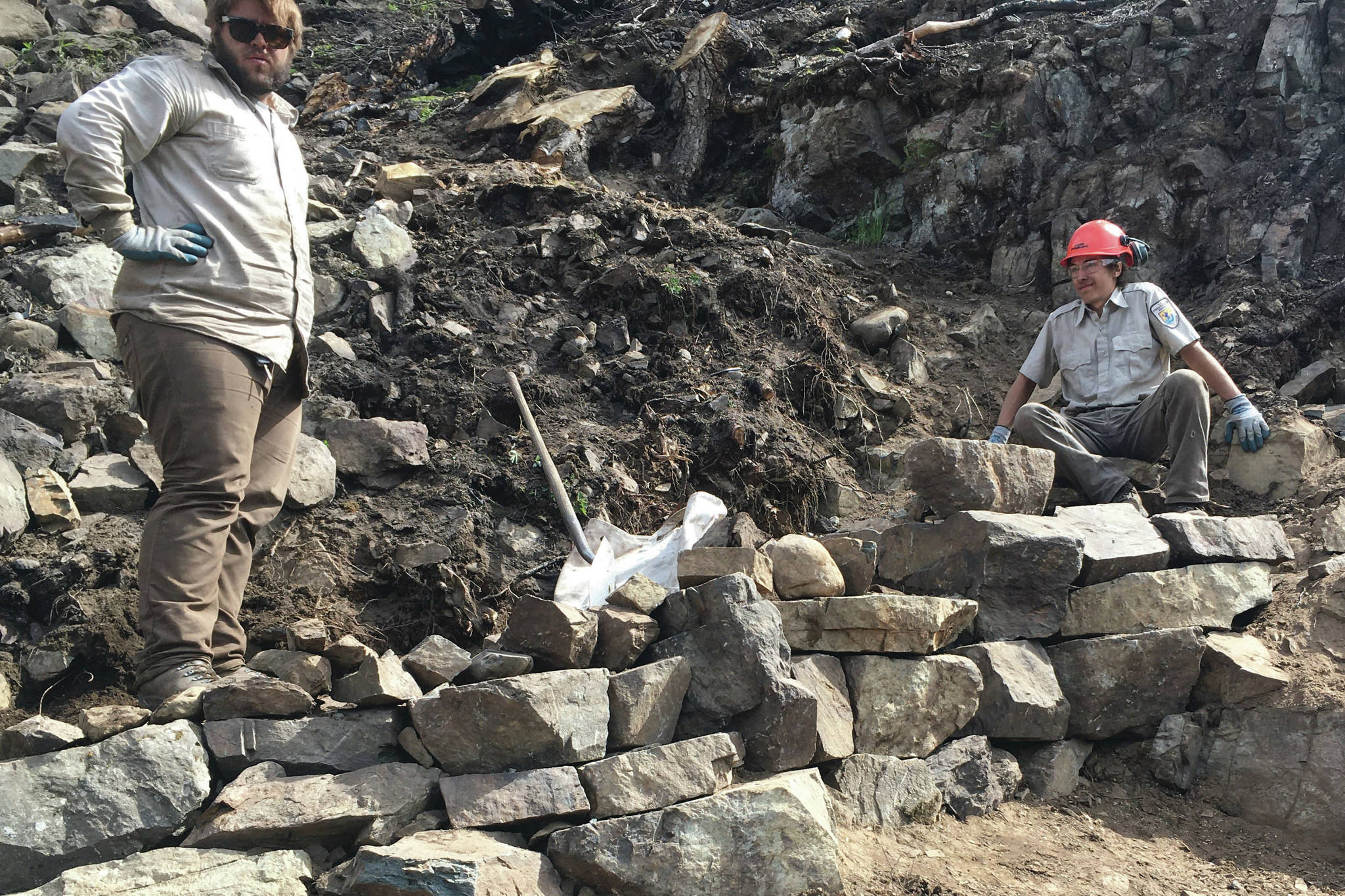Skyline Trail was the top priority for getting trail work done and getting the trail reopened for the public to enjoy. Skyline is arguably our most popular trail on the Kenai National Wildlife Refuge for the locals of the Kenai Peninsula.
In early May, the log-out process started off getting the trail open.
Trail crew members worked on logging out and cutting down hazard trees for a week to ensure easy access to and from the trail. Clearing logs also allowed the crew to see the issues with the trail tread in order to make an assessment for what repair work needed to be done. The goal of the trail work was to leave Skyline in good shape and safe enough to open for the public.
Once the trail was logged out, hazard trees where taken care of and the trail was deemed safe to work on, the trail crew started from the top and worked their way down the mountain repairing trail tread. The trail crew started right at the top of the saddle and worked on reclaiming the bench tread that was being lost and eroding away due to unstable ground around it.
Digging the bench of the trail took the crew roughly about a week to complete, moving faster than we had expected. However, that didn’t mean we were ready to open the trail. Once the majority of the tread was taken care of it was now time to focus on the “project work” of fixing the trail.
This project work consisted of more hazard tree falling, major work with rock in what we call the “rock face,” setting log check steps and other small projects filling holes and fixing more tread issues.
The main project work was in an area that has been looked at for years, but the main questions arose: Do we have the time in the season to tackle this project and do we have the skill level?
Some could say that the Swan Lake Fire was a blessing for Skyline because it forced us to sacrifice other trail work for the season. This allowed us to spend time and work on this trail to build things to make this trail more self-maintaining and longer lasting.
We started with digging bench along most of the trail. Second, we focused on the “rock face” area and doing the rock work.
This rock work consisted of removing decent size rocks from within the trail itself so hikers would not be doing a balancing act from rock to rock. In spots along this section the trail crew was able to build several rock walls by using the rock material in the area.
This is done by building tier levels. Starting with an in-slope for the foundations using the biggest rocks possible, we worked from the low end of the foundation toward the higher end, attempting to match the faces of the rocks together, establishing good contact points between each pair of rocks.
We placed a rock in each tier so they break their joints between rocks in the tier directly below the next tier, backfilling with small stones or crushed rock and packing the crush into all the voids in the back of the wall to create a stable surface.
Once the steps above have been completed then it’s time to repeat until you have built your wall up to the height of the tread with the rest of the trail. Working on the rock wall sections fixing the trail took the trail crew roughly two weeks to complete.
After the rock sections of the trail were completed, it was now time for the finishing touches on the trail. Crew members took a few days to hike the trail to make sure sections were not missed and sections that needed to be attended to were attended to.
In all, it took the refuge trail crew about seven weeks this spring and early summer to get Skyline Trail to a point that we felt it was safe to open for the public.
Just because we spent that amount on Skyline doesn’t mean it’s perfect by any means. There have been several day trips up the trail to check the status, fix any issues that have popped up and to cut trees off the trail when needed.
As fall begins to pass and winter settles in, the trail crew will be off for the winter and back at it in the spring. The trail crew will be working on burn trails again next summer, fixing any issues that have not been addressed yet or new issues that may appear.
Along with the burn trails we will be able to start to refocus on the nonburn trails again to fix some of the maintenance issues that were not able to be addressed this season.
Of the eight trails that where affected by Swan Lake Fire in 2019, seven out of eight have been completely reopened and have had trail crew time spent on working on them.
Surprise Creek Trail remains the one trail still closed. Several log-out attempts happened on the trail to open it up, but time was against the trail crew for this one.
We hope everyone is able to get out and enjoy the trails throughout the remainder of the fall and into the winter months.
Christa Kennedy is the Trails Volunteer Coordinator for the Kenai National Wildlife Refuge. Find more Refuge Notebook articles (1999–present) at https://www.fws.gov/refuge/Kenai/community/refuge_notebook.html.


